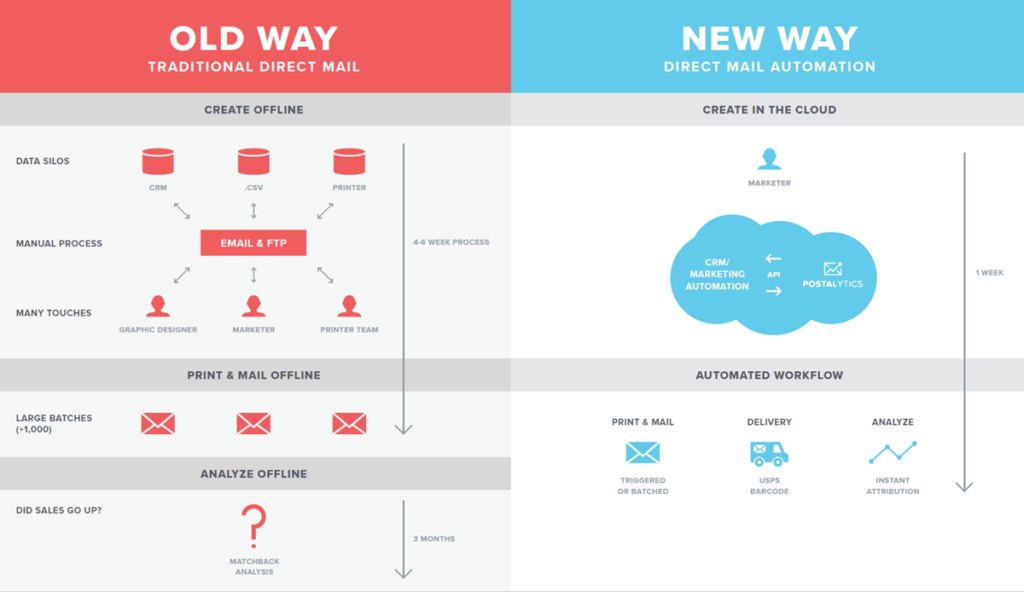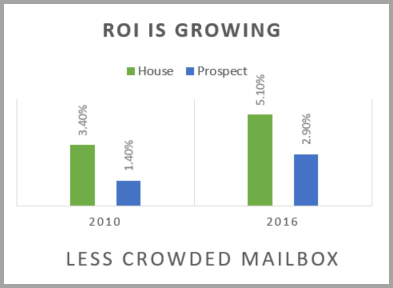
Digital and email marketing have captured many headlines in the last decade. Unfortunately, not all of the headlines have been positive.
High profile data privacy scandals and the growing email overload dynamic are driving savvy digital marketers to take a new look at offline marketing channels.
Direct mail marketing is a traditional channel that can combine the targeting and scalability of digital with the authenticity and trust of traditional marketing.
81% of marketers plan to maintain or increase usage of direct mail in the next 12 months. (Source: ANA/DMA Response Rate Report 2018) @ANAmarketers
As a result, a new generation of digital native marketers are asking questions like: What is direct mail marketing? How can I test it out in a smart, efficient way? Can it boost my inbound marketing ROI?
What is Direct Mail Marketing?
To put it simply, direct mail marketing is the process of creating and sending of advertising campaigns that use the mail system for delivery. The process includes:
- Audience research
- List building
- Graphic design that fits mail specifications
- Copywriting
- Printing & mailing
- Tracking of results
Watch Direct Mail Automation Overview Video
What kinds of marketing campaigns utilize direct mail?

Lead generation has been the traditional strength of direct mail. Why? There are an abundance of mailing list data sources that allow a marketer to quickly zero in on specific audiences that are likely to be interested in an offer. Here’s a few common lead generation campaigns:
- A new restaurant mails a grand opening postcard with a built in coupon for a free dessert to all homeowners within a 5 mile radius.
- A software company sends a letter invitation to a dinner to the CEO’s of commercial real estate firms with more than 2,000 employees within 3 counties surrounding the event.
- A direct to consumer female athletic wear brand sends oversized postcards to females in an A/B test: Group A with incomes between $75-$100k/year, Group B with incomes between $101k-$125k/year.
More recently, nurture, loyalty and win-back campaigns are being deployed with direct mail as a part of a multi-channel strategy. This is being driven by new technology that connects direct mail to the CRM and Marketing Automation tools that typically serve as the backbone of these types of campaigns.
- A catering company targets email non-openers with large postcards highlighting images of seasonal specials that help them stand out from other caterers.
- A data science marketing company triggers a personal letter from their CEO to known leads that download a high value piece of content.
- An e-commerce company gets huge ROI gains by adding direct mail to an existing email based win-back campaign.
Direct mail is a very deep marketing channel, with a richness in the variety of different types of materials to send and ways to use the channel to make connections with your ideal customers.
Let’s dive into the nuts and bolts of what a direct mail marketing campaign looks like:
The Direct Mail Marketing Process

To answer the question “What is direct mail marketing?” we have to cover the actual process that companies use to design, create, and deliver campaigns. While every company might use slightly different processes from the next, the general steps involved in creating a direct mail campaign include:
- Choosing a Demographic. Who is your campaign going to be sent to? The more specific your demographic, the more specific you can be in your messaging.
- Recipient Identification and list building. Once you know who you are sending your campaign to, you have to create a list of recipients that will meet that criterion. Your list could come from in-house data, or you could source data from a third party. Here at Postalytics, we offer detailed list building features that make this step extremely simple for our customers.
- Brainstorming and designing your campaign. First, you have to choose how you will present your offer. When you’ve done that, you can decide on the type of collateral that you will use (postcards, letters, etc.). Then, most companies work with graphic designers and copywriters to design the collateral and perfect the messaging. With Postalytics, you can use our professional direct mail design templates and drag-and-drop campaign builder to speed up this step and reduce the cost of sending your campaign.
- Printing and mailing. Once you have your list build and designs nailed down, then you have to print and mail your campaign. Using our system, all of this can be handled through our system.
- Tracking of delivery and response. With detailed IMB delivery tracking, and online response pURL tracking, you can see who engages with your direct mail campaigns, even if they never fill out a data capture form. Over time, you can use this information to improve the campaigns that you send.
What Is The Best Way To Test Direct Mail?
Direct mail automation tools enable marketers to quickly assemble campaigns that can help them test impact that direct mail can have at various stages of their marketing/sales funnels. If you’re committed to a data driven approach to marketing, you’d be crazy not to embrace these tools.
What’s more, these tools can have free accounts that don’t require any commitment, or month to month subscriptions that offer discounted per piece fees for each mailer sent in a test.
We recently published a detailed guide to direct mail testing. It goes into depth on how experts construct and conduct direct mail tests. We highly recommend reading it to anyone that is interested in testing.
Below is a basic outline of the steps required to brainstorm, design, and deliver high-quality direct mail campaigns to a targeted audience. Imagine constructing a testing process that uses “the old way”. You’ll notice that the newer direct mail automation workflow is far more streamlined, while involving fewer moving parts.

Watch Direct Mail Automation Overview Video
What Types Of Businesses Use Direct Mail?
The ability to send specific messages to specific audiences at scale and with automation makes direct mail an effective marketing channel for nearly any industry.
B2C Industries
Direct mail marketing is often thought of as primarily a B2C channel. Among the industries that typically send a lot of direct mail:
- Healthcare (physician & dentist offices, urgent care centers, etc)
- Hospitality & Travel (restaurants, hotels, travel agents)
- Retail & Ecommerce
- Real Estate
- Financial Services (banking, investment advice, insurance)
- Education (colleges & universities, private schools, adult education)
- Non profit
- Automotive
B2B Industries
Increasingly, B2B marketers are embracing direct mail to augment their investments in marketing automation and CRM. It is being used for traditional top of the funnel lead generation campaigns as well as lower in the funnel nurturing and post sale loyalty campaigns. Common industries include:
- B2B Tech (this is growing very quickly)
- B2B Financial Services (banking/lending, insurance)
- Commercial Real Estate
- B2B Media
- Professional Services (accounting, consulting)
- Legal Services
- Staffing & Recruitment
- B2B Ecommerce
Any company that sells a product, service, or has a compelling offer could potentially benefit from integrating direct mail into their marketing campaigns. The effectiveness of direct mail as a channel is more reliant on the quality of your mailing list, your offer, and how you present it than it is dependent on your industry.
What Kind of Results Can I Expect from Direct Mail Marketing?

Often digitally oriented marketers are unaware of just how effective direct mail can be. The resurgence in direct mail ROI has been an under the radar phenomenon that not every marketer is aware of.
Direct mail is one of the most cost effective ways to get your brand’s offer, logo, message, and image directly in front of your customers and prospects.
According to a study from the Data & Marketing Association (DMA), the ROI of the median direct mail campaign is 29%, with a response rate for direct mail was 5.1% (for house lists). This is much higher than email, which only enjoyed a 0.6% response rate. That same study also showed that 42% of consumers read or scan direct mail before they throw anything away.
Of course, the overall effectiveness and ROI delivered on any specific marketing campaign depends on a large number of factors, including but not limited to:
- Where does your mailing list come from? Is it a house list? Did it come from a third-party data source? Have you contacted the recipients before? Your campaign’s effectiveness will depend on the quality of your list. Warm, relevant prospects will deliver a higher ROI than cold recipients every time.
- How appealing is your offer? A better offer generates a higher response rate and more revenue overall. Using tried and true marketing techniques like calling your recipients to action, placing a time limit on your offer, and warming your prospects before asking for the sale all can help you to improve the efficiency of each campaign.
- Are you able to track the campaign? Modern direct mail systems provide the ability to track engagement from your direct mail campaigns through in-depth analytics. Taking a more data-backed approach to your direct mail marketing will allow you to optimize your campaigns over time.
- What is the cost of your direct mail campaign? The cost of sending direct mail campaigns effects your ROI. More expensive campaigns may generate more interest, but the additional costs may offset that increase in engagement.
In the end, direct mail is an extremely effective marketing channel. There are many aspects of your campaign that will play a role in the ROI that direct mail delivers.
Why Is Direct Mail Rebounding?

Direct mail is currently experiencing a resurgence in popularity. Over the last two decades, as companies have embraced digital channels and marketing departments have pushed themselves farther away from traditional marketing channels, many have lost sight of the importance that offline channels like direct mail, radio, and television advertising can provide.
There are a few core reasons why direct mail marketing is currently undergoing this rebound:
- Digital channels are becoming too competitive. As more companies pursued digital marketing in order to gain a competitive edge, the seen has become increasingly competitive. Direct mail outperforms many digital channels by a significant margin. As companies begin to explore traditional marketing channels, they are often surprised by the results they are able to secure.
- Direct mail automation is changing the game. Modern direct mail campaigns are integrated and data-driven compared to the direct mail campaigns of old. Using in-depth analytics and pURL tracking, modern systems are able to help companies better understand what is working and what is not within their campaigns, then optimize them over time. Today, brands have to spend less time building lists, designing campaigns, and delivering their materials while using more detailed analytics to increase the return that their campaigns generate.
- Direct mail marketing is more reliable. Digital channels experience huge fluctuations in competitiveness, pricing, and trending tactics and strategies. Direct mail is largely a very reliable medium. During the 2008 recession, direct mail marketing was less affected than other marketing channels and rebounded more quickly.
- A growth in multi-channel approaches. Using modern marketing systems, companies are more equipped to engage their recipients through multiple marketing channels. Direct mail can fit seamlessly into multi-channel marketing strategies at nearly any stage of the funnel.
These are just a few of the many reasons why direct mail marketing has experienced a serious rebound among small, medium, and large companies alike.
Direct Mail is a Reliable Choice
Watch Direct Mail Automation Overview Video
Direct mail is an extremely effective and flexible addition to any larger marketing strategy. If you are considering integrating direct mail into your current campaigns and expanding your multi-channel approach, click here to sign up for Postalytics for free and start designing your first campaign!
About the Author

Dennis Kelly
Dennis Kelly is CEO and co-founder of Postalytics, the leading direct mail automation platform for marketers to build, deploy and manage direct mail marketing campaigns. Postalytics is Dennis’ 6th startup. He has been involved in starting and growing early-stage technology ventures for over 30 years and has held senior management roles at a diverse set of large technology firms including Computer Associates, Palm Inc. and Achieve Healthcare Information Systems.
